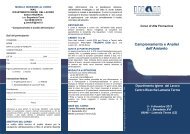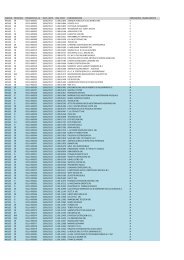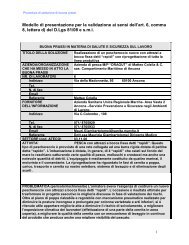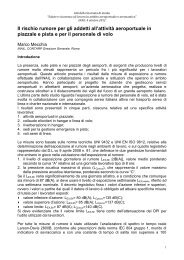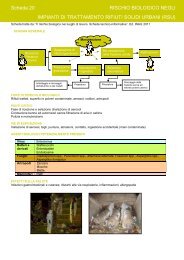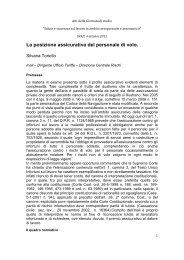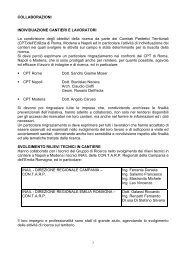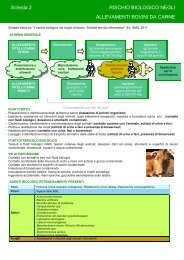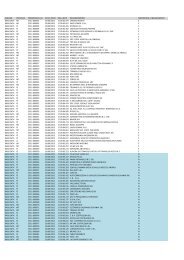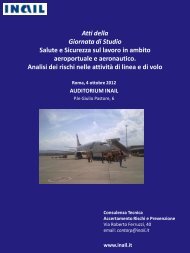il rischio da vibrazioni al corpo intero per le attivita' svolte sui mezzi ...
il rischio da vibrazioni al corpo intero per le attivita' svolte sui mezzi ...
il rischio da vibrazioni al corpo intero per le attivita' svolte sui mezzi ...
- No tags were found...
You also want an ePaper? Increase the reach of your titles
YUMPU automatically turns print PDFs into web optimized ePapers that Google loves.
Atti della Giornata di studio<br />
“S<strong>al</strong>ute e sicurezza sul lavoro in ambito aeroportu<strong>al</strong>e e aeronautico”<br />
INAIL 4 ottobre 2012<br />
t cr sup = durata dell‟esposizione oltre la qu<strong>al</strong>e viene su<strong>per</strong>ato <strong>il</strong> v<strong>al</strong>ore<br />
(A(8) = 0,86 m/s 2 ) assunto <strong>da</strong>lla curva B.1 su<strong>per</strong>iore della norma<br />
UNI ISO 2631 (Appendice B) in corrispondenza di un <strong>per</strong>iodo di esposizione<br />
di 8 ore;<br />
Ai fini della re<strong>da</strong>zione del Documento di V<strong>al</strong>utazione dei Rischi, ovviamante, non si può<br />
prescindere <strong>da</strong> un approccio incentrato <strong>sui</strong> singoli lavoratori esposti, <strong>da</strong>lla stima dei tempi di<br />
esposizione e <strong>da</strong>l c<strong>al</strong>colo del<strong>le</strong> relative esposizioni giorn<strong>al</strong>iere A(8).<br />
Occorre inoltre considerare la possib<strong>il</strong>ità di esposizione multipla a più sorgenti di vibrazione<br />
(gui<strong>da</strong> di <strong>mezzi</strong> differenti nell‟arco di una giornata lavorativa).<br />
Per esposizioni giorn<strong>al</strong>iere variab<strong>il</strong>i, bisogna infine considerare <strong>il</strong> “livello giorn<strong>al</strong>iero massimo<br />
ricorrente” (D.Lgs. 81/08).<br />
RISULTATI<br />
Mezzi aeroportu<strong>al</strong>i<br />
Tenuto conto che l‟attività si svolge su turni di 8 ore, sono <strong>da</strong> tenere in considerazione tutti i<br />
tempi critici che risultano minori o ugu<strong>al</strong>i a t<strong>al</strong>e v<strong>al</strong>ore.<br />
I tempi critici di azione (t cr az ), quando oltrepassati, determinano <strong>il</strong> su<strong>per</strong>amento del v<strong>al</strong>ore<br />
d‟azione; essi rappresentano <strong>per</strong>iodi di esposizione effettiva <strong>al</strong>la gui<strong>da</strong>, <strong>al</strong> netto di soste e<br />
pause.<br />
Il <strong>da</strong>tore di lavoro può verificare se <strong>il</strong> mezzo esaminato viene effettivamente ut<strong>il</strong>izzato<br />
<strong>da</strong>ll‟o<strong>per</strong>atore <strong>per</strong> un <strong>per</strong>iodo su<strong>per</strong>iore o inferiore <strong>al</strong> tempo critico c<strong>al</strong>colato.<br />
Si constata che può verificarsi condizioni <strong>il</strong> su<strong>per</strong>amento del v<strong>al</strong>ore d‟azione <strong>per</strong>:<br />
a) automezzo High Loader: t cr az = 6,4 ore;<br />
b) automezzo-nastro trasportatore: t cr az = 6,3 ore;<br />
c) trattorino e<strong>le</strong>ttrico: t cr az = 2,8 ore;<br />
d) autobotte acqua potab<strong>il</strong>e: t cr az = 5,2 ore;<br />
e) autosc<strong>al</strong>a passeggeri: t cr az = 3,9 h;<br />
f) trattorino: t cr az = 6,2 h;<br />
g) autosc<strong>al</strong>a passeggeri: t cr az = 0,6 ore;<br />
h) automezzo nastro trasportatore carico/scarico bagagli: t cr az = 6,0 ore;<br />
i) autobotte acqua potab<strong>il</strong>e: t cr az = 3,0 ore;<br />
j) trattorino e<strong>le</strong>ttrico 2: t cr az = 2,5 ore;<br />
k) trattorino 1 traino gruppo e<strong>le</strong>ttrogeno: t cr az = 0,9 ore.<br />
Occorre prestare particolare attenzione ai <strong>mezzi</strong> g e k, in quanto <strong>il</strong> tempo critico t cr az , relativo <strong>al</strong><br />
su<strong>per</strong>amento del v<strong>al</strong>ore d‟azione, risulta inferiore a un‟ora.<br />
Tra i <strong>mezzi</strong> precedenti, suscettib<strong>il</strong>i di su<strong>per</strong>are <strong>il</strong> v<strong>al</strong>ore d‟azione, in gener<strong>al</strong>e i tempi critici t cr lim<br />
sono risultati su<strong>per</strong>iori <strong>al</strong><strong>le</strong> 8 ore, <strong>il</strong> che esclude la possib<strong>il</strong>ità di su<strong>per</strong>amento del v<strong>al</strong>ore limite<br />
(fermo restando che <strong>il</strong> turno di lavoro non su<strong>per</strong>i <strong>le</strong> otto ore), tranne che <strong>per</strong> g e k, <strong>il</strong> cui t cr lim ,<br />
risulta invece ben inferiore <strong>al</strong><strong>le</strong> 8 ore.<br />
Si pone in evidenza che <strong>il</strong> mezzo g, nel<strong>le</strong> condizioni di misura, risulta su<strong>per</strong>are <strong>il</strong> v<strong>al</strong>ore<br />
limite <strong>sui</strong> <strong>per</strong>iodi brevi (1,5 m/s 2 ), mentre <strong>il</strong> mezzo k, pur non su<strong>per</strong>andolo, raggiunge <strong>il</strong><br />
v<strong>al</strong>ore limite <strong>per</strong> i <strong>per</strong>iodi brevi (1,5 m/s 2 sull’asse z).<br />
3



